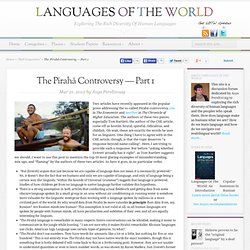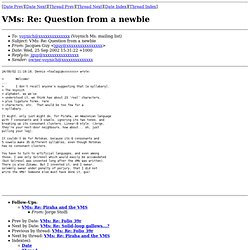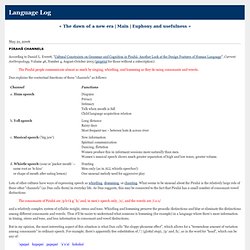

PIRAHA UPDATE. The Pirahã Controversy — Part 1. Two articles have recently appeared in the popular press addressing the so-called Pirahã controversy, one in The Economist and another in The Chronicle of Higher Education.

The authors of these two pieces, especially Tom Bartlett, the author of the CHE article, come off as hostile, brutal, spiteful, ridiculous, and childish. Oh wait, these are exactly the words he uses for us linguists. One thing I have to agree with in the CHE article, though, is that the topic deserves “a response beyond name-calling”. Here, I am trying to provide such a response. But before “asking whether Everett actually has it right”, as Tom Bartlett suggests we should, I want to use this post to mention the top-10 most glaring examples of misunderstanding, mix-ups, and “flaming” by the authors of these two articles. ”But [Everett] argues that just because we are capable of language does not mean it is necessarily prewired.”
Like this post? VMs: Re: Question from a newbie. [Date Prev][Date Next][Thread Prev][Thread Next][Date Index][Thread Index] 24/09/02 11:18:18, Dennis <tsalagi@xxxxxxxx> wrote: > Welcome!

... > I don't recall anyone's suggesting that [a syllabary]. > The Voynich > alphabet, as we've > understood it, we think has about 23 'real' characters, > plus ligature forms, rare > characters, etc. That would be too few for a > syllabary. It might, only just might do, for Piraha, an Amazonian language with 7 consonants and 3 vowels, ignoring its two tones, and breaking up its consonant clusters, Linear-B style.
Piraha apotheosis (and that is an understatement) Even more Piraha weirdness. Piraha (Re: VMs: Welsh/Cornish) More Piraha. Re: REPOST: More on Piraha. Squabble. Pirahã channels. Pirahã channels According to Daniel L.

Everett, "Cultural Constraints on Grammar and Cognition in Pirahã: Another Look at the Design Features of Human Language", Current Anthropology, Volume 46, Number 4, August-October 2005 (preprint for those without a subscription): The Pirahã people communicate almost as much by singing, whistling, and humming as they do using consonants and vowels. Dan explains the contextual functions of these "channels" as follows: Lots of other cultures have ways of expressing speech as whistling, drumming, or chanting. The consonants of Pirahã are /p b t k g ' h/ and, in men's speech only, /s/, and the vowels are /i a o/ and a relatively complex system of syllable-weight, stress and tone. But in my opinion, the most interesting aspect of this situation is what Dan calls "the sloppy phoneme effect", which allows for a "tremendous amount of variation among consonants" in ordinary speech. 'apapaí kapapaí papapaí 'a'a'aí kakakaí (and so on) but not.
Researcher's Findings in the Amazon Pit Him Against Noam Chomsky - The Chronicle Review. By Tom Bartlett A Christian missionary sets out to convert a remote Amazonian tribe. He lives with them for years in primitive conditions, learns their extremely difficult language, risks his life battling malaria, giant anacondas, and sometimes the tribe itself. In a plot twist, instead of converting them he loses his faith, morphing from an evangelist trying to translate the Bible into an academic determined to understand the people he's come to respect and love.
Along the way, the former missionary discovers that the language these people speak doesn't follow one of the fundamental tenets of linguistics, a finding that would seem to turn the field on its head, undermine basic assumptions about how children learn to communicate, and dethrone the discipline's long-reigning king, who also happens to be among the most well-known and influential intellectuals of the 20th century. It feels like a movie, and it may in fact turn into one—there's a script and producers on board. Nevins%20et%20al%202007%20Piraha%20Exceptionality.